Is the cut of your diamond or precious gemstone the same as its shape?
This is confusing to most engagement ring newbies. Surely the diamond is cut into the particular shape you want, isn’t it?
Well, yes and no.
The cut is created by a skilled jeweler to bring out the best characteristics of the shape and to extract its maximum brilliance.
Of course, the cutter needs to cut the rough diamond into a certain general shape, but the diamond’s shape refers to its overall form, geometry or appearance – for example, round, square or pear-shaped.
The cut refers to its proportions, symmetry, number of facets and ultimately its ability to reflect brilliance and light within the stone, emphasizing and flattering the form, if it is masterfully done.
Certain cuts have been developed over the ages to complement certain shapes of diamond because they lend themselves to allowing more light and brilliance into that shape than other cuts.
Cut and shape work TOGETHER to create a diamond’s overall impact – and they are critical partners in determining the look of your engagement ring.
The cut of the stone determines its overall proportion, symmetry, polish and dazzle, and it is the most important of the so-called 4Cs of diamond quality measurements, which are cut, color, clarity and carat weight.
In a well-cut diamond, the light enters through the top part of the stone, called the table, and then it is reflected off the angles it meets within the body of the stone, exiting again out of the top.
As the light bounces around inside the stone it creates three types of sparkling effects:
- Fire: These are the flashes of red and other colors you will see when you move the ring.
- Brilliance: These are the natural white light reflections on and within the stone.
- Scintillation: This is the shine given off the stone or light source as it moves.
Taken in combination, these three effects are the reason a diamond will catch your eye and appear to be glowing from within.
If a stone is badly cut, the light will pass through the top, but then it will leak out of the sides and end up looking dull to the naked eye, even if it is a heavy carat weight.
A skillful cut will make the most of any carat weight stone, but a bad cut can make an expensive, heavy carat weight stone look dull, which is a big waste of your money!
Understanding Diamond Shape
Let’s start from the beginning: the shape of the stone is where you should start.
There are 10 main diamond shapes that offer different advantages and looks – although you will probably think of only 1, which is the traditional round solitaire. There are many more alternatives, however.
The shape you choose will determine its style, brilliance, design and even its price, so you can appreciate the importance of learning about them all.
If you open your mind to considering other shapes and their cuts, you will find there is an amazing variety from which to choose your perfect one.
Your choice will depend largely on your taste, but there are some practical, style tips you can follow to help make your decision. Again, the shape you choose will determine the cut your stone will be given.
Here are general tips on the best shapes for your finger type:
- Round diamond shapes work for any hand shape, large or small.
- Women with shorter fingers should try elongated shapes such as Pear, Marquise or Oval as they will tend to make fingers look longer and more slender. Narrower bands can make short fingers look longer.
- Women with long fingers look good with square shapes such as Radiant, Cushion and Princess cuts. Longer fingers can also carry a wider band.
- Women with slender fingers can wear smaller stones and a medium thickness band.
- Women with small hands need to avoid being overpowered with elaborate rings. Small Round, Princess, Cushion or Heart shapes stones work well.
- Women with large hands should avoid delicate, slender rings, but heart and round shapes can be more flattering. Larger rings with bold designs work well with big hands.
Bottom line advice: If possible, try on as many different shapes as you can before making a commitment!
Your ring will be worn for a long time, so it makes sense to choose the right shape to show off your finger and hand shape.
10 Popular Diamond Shapes for Engagement Rings
Here are the 10 popular diamond shapes available:
1. Round Cut Diamonds
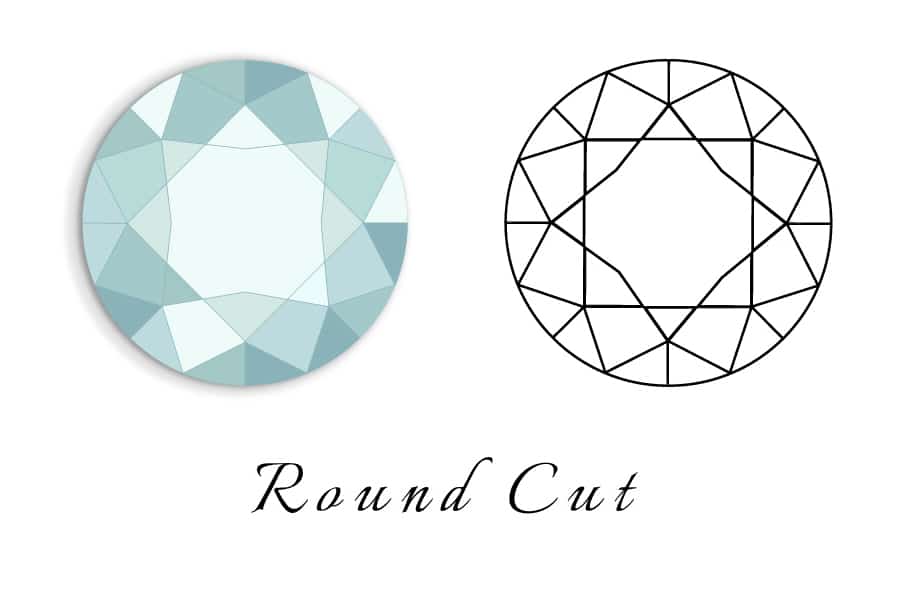
The round cut diamond shape has been a traditional look for engagement rings for decades, particularly after advances in the brilliant style of cutting, and it remains the number one choice for engaged couples to this day.
So-called “brilliant” cutting creates multiple facets which reflect the maximum light return, and as round diamonds face upwards, they reflect more light return than some other diamond shapes.
Simply put, you get a brighter, more sparkling ring.
Pros
- By far the most popular of all diamond shapes, the round brilliant accounts for about 75% of all engagement rings sold in the U.S.
- This is a classic shape, developed early in the 20th century to accentuate a diamond’s inherent light and brilliance.
- The round brilliant cut consists of 58 expertly cut facets, which throw off maximum
- Versatile shape which looks good in any setting, or as a single solitaire.
- Round shaped diamonds look good on any finger shape
Cons
- Round diamonds tend to cost more per carat because the demand is very high, and the yield is relatively low as more of the rough stone is lost in its cutting
- A typical round diamond may cost 25-35% more than a similar fancy shape.
The Look: Punch up the round brilliant in a halo setting, with side diamonds or wear it as a sophisticated solitaire; it’s a simple, clean look which flatters any hand or finger shape. The round brilliant is for the classic bride-to-be who favors tradition over trend.
2. Princess Cut Diamonds
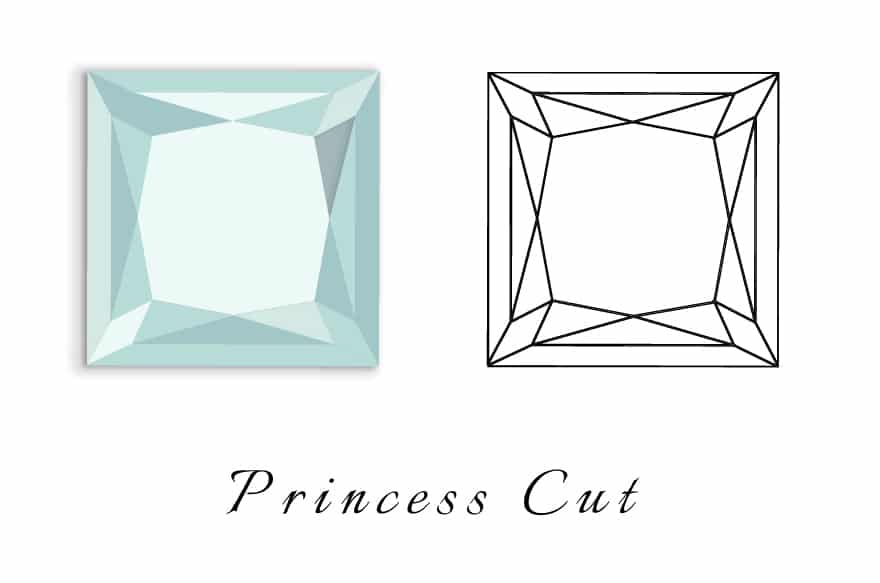
The Princess it is the second most popular choice of diamond shape for engagement rings. It can be square or moderately rectangular and looks equally dramatic in a contemporary or antique styled setting.
It was first created in 1980 and has gradually become the most celebrated and popular of the fancy shapes for diamonds, especially favored for engagement rings.
Like round diamonds, princess cut diamonds are a good choice for their flexibility in working in almost any style of ring.
Star Jones’s engagement to investment banker Al Reynolds was celebrated with a 7-carat Princess cut diamond surrounded by baguette and round diamonds set in platinum.
Pros
- Princess diamonds have a slightly lower price per carat than round cut diamonds, because the shape of the princess cut allows two equally sized princess cut diamonds to be cut from the same rough stone with relatively little waste. The greater efficiency, or yield translates to a lower price.
- This is the most brilliant of the so-called “fancy” shapes, with intense faceting.
- Princess cut diamonds are versatile and look good in most settings.
- Princess cut diamonds hide inclusions and poor coloring well, so you can save money in those areas.
Cons
- This shape’s pointed corners can catch on clothing and could be vulnerable to chipping or breaking, so the setting needs extra protection for the stone.
The Look: The squared-off look with its elegant, clean angles looks both classic and fresh. It is versatile, chic and works well in almost any ring style.
3. Cushion Cut Diamonds
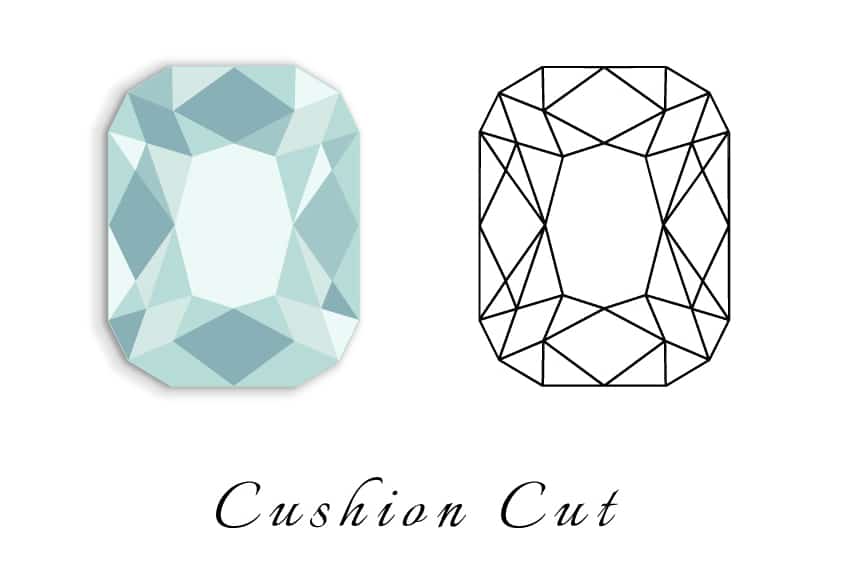
Originally known as the “old mine” cut, the Cushion shape has been around for centuries. It consists of a square or rectangular shape with rounded-off corners – and it looks a lot like a cushion, hence its name.
The Cushion was the most popular diamond shape for around a hundred years and was as popular in the 1900s as the round brilliant is today.
While generally less brilliant than round brilliant diamonds, cushion cut diamonds often have better fire which is part of their appeal.
Pros
- Has an attractive, vintage look, which is a cross between a Princess and a Round.
- No sharp edges to catch on clothing!
Cons
- Because it has large facets, the Cushion cut shows poor coloration, inclusions and flaws in the diamond, so you have to buy a good quality stone to avoid this.
The Look: The Cushion has an antique, vintage look, echoing the romance of the Art Deco period. If you’re a Great Gatsby fan, you’ll remember that Daisy Buchanan’s engagement ring was a Cushion cut halo. Distinctive, glamourous, opulent, romantic, the Cushion reflects your taste for vintage luxury.
4. Emerald Cut Diamonds
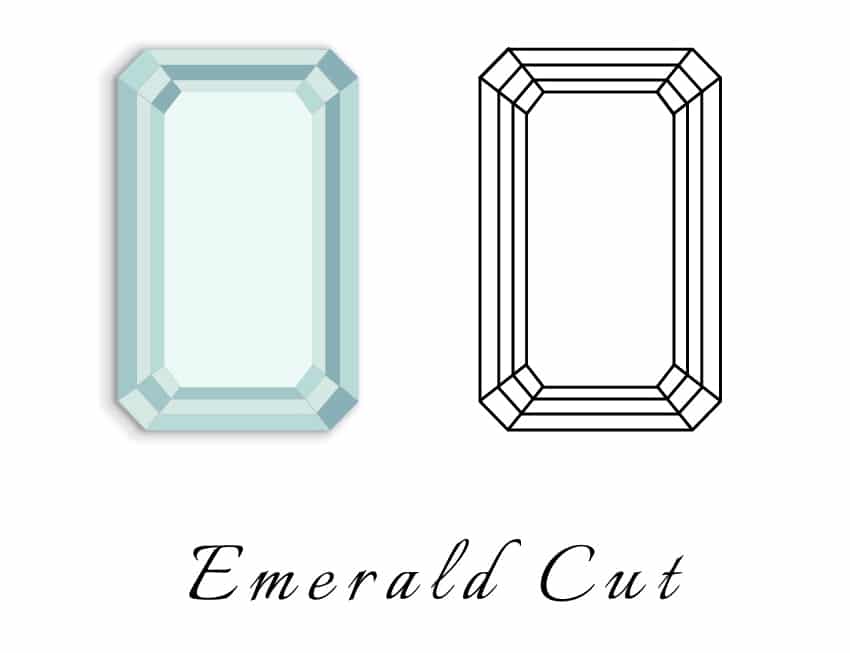
Elegant and sophisticated, the Emerald shape varies from nearly square to a narrow rectangle… Its unique look features a flat surface and chiseled step cut sides, giving it a larger appearance than other diamonds of the same carat weight.
While you won’t get the immediate sparkle of a round brilliant-cut diamond, the Emerald cut will give you drama and distinction in spades.
The shape was originally developed for the cutting of emeralds, hence its name.
Because this cut has a wide, flat table, flaws and color clarity tend to be more visible, so you’ll want to opt for a high-grade stone.
Pros
- The large table and long facets enhance the color and clarity of the stone.
- With an 8-edged cut, it does not snag on clothing and is durable for everyday wear.
- The Emerald cut is one of the most affordable diamond shapes you can buy.
- Your fingers look longer with this shaped diamond, so it is flattering for those with short fingers.
Cons
- It is not a flashy or brilliant cut so don’t expect lots of sparkle.
- Needs an expert cutter to avoid problems in the finished product
- Because it shows flaws in the stone, you need to buy a high-quality colorless diamond
- The Look: Classic, timeless yet with an edge, the Emerald shape reflects a confident woman with refined taste. J. Lo, Amal Clooney and Beyoncé all have Emerald cut engagement rings.
5. Oval Cut Diamonds
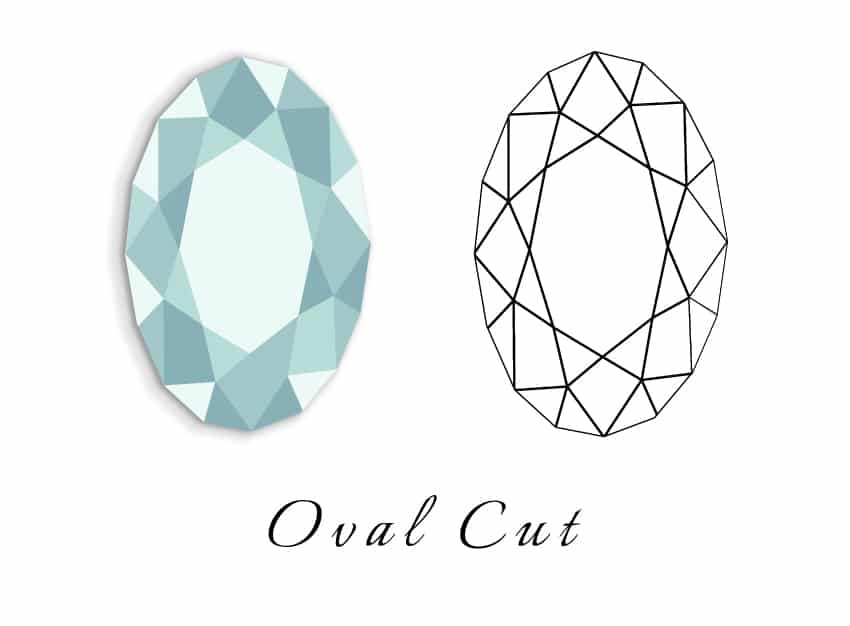
The Oval is a unique take on a classic shape. The Oval shape was created by Lazare Kaplan in the 1960s and is a modified brilliant cut, so you’ll get the fire and brilliance of a traditional round cut, but in a more distinctive, elongated shape.
Because the round and oval shapes have similar fire and brilliance, the oval is an ideal choice for a customer who likes the look of a round diamond but wants something more unique.
Oval diamonds have the added advantage of an elongated shape, which can create the illusion of greater size.
Pros
- Perfect for shorter fingers, as this cut elongates them
- An affordable cut but finding a high-quality Oval is sometimes not easy.
- High sparkle and brilliance due to many facets, but not in a round shape.
- Durable for everyday wear as there are no sharp edges.
Cons
- Shows inclusions and flaws, so you need a high-quality diamond to avoid this.
- Most Ovals show a bow-tie effect, if not properly cut.
The Look: The Oval tends to give the illusion of greater size and makes the wearer’s fingers look longer and more tapering fingers.
Kate Middleton’s engagement ring, although a sapphire, is an Oval.
A sophisticated choice, the Oval appeals to the bride-to-be who likes both sparkle and sophistication – and dares to be a little different.
6. Asscher Cut Diamonds
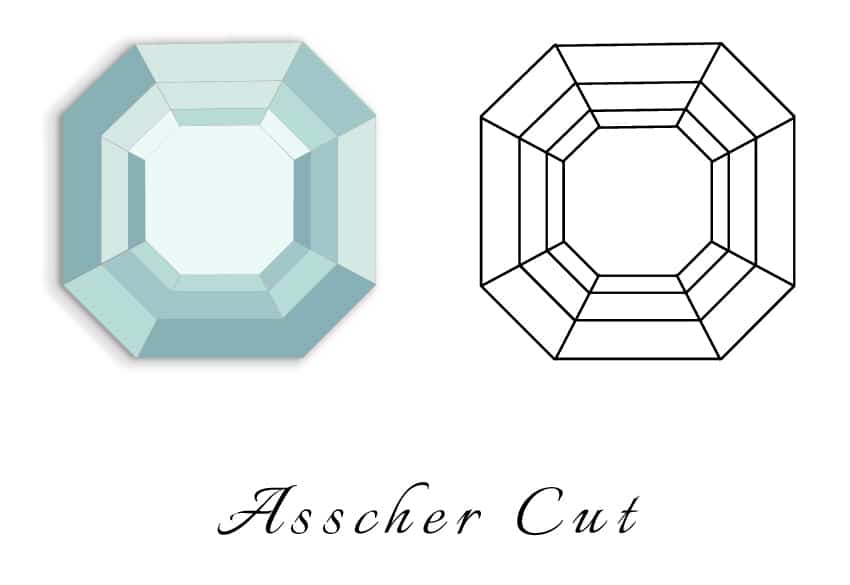
An Asscher Cut diamond is a form of an octagonal, square emerald cut with squared off corners. It was first cut in 1902 by the Royal Asscher Diamond Company.
The octagonal shape has layered facets and a high crown, offering brilliance and giving it widespread appeal. The original Asscher cut has 58 facets and the Royal Asscher Cut has 74 facets.
Pros
- The Asscher cut looks good on most finger types.
- It suits many tastes and is versatile in different settings
- Brilliant and unique appearance.
- Durable, with no sharp corners to snag on clothing.
Cons
- As it is a deep cut, much of the diamond is hidden, so it doesn’t show the carat weight of the stone to its best advantage.
- This cut also shows blemishes and inclusions, so you will need to buy a high-quality stone
The Look: Asscher cut diamonds make beautiful center stones that have the look of a vintage diamond, with the brilliance of a more modern diamond.
They have become increasingly popular over the last two decades, especially after appearing in “Sex and the City” and on Gwyneth Paltrow’s engagement ring.
The latest celebrity wearer is Pippa Middleton, sister of Kate Middleton. Her stunning engagement ring features a 3 carat Asscher cut diamond surrounded by a halo of smaller diamonds that’s said to be worth $263,000.
7. Pear Cut Diamonds
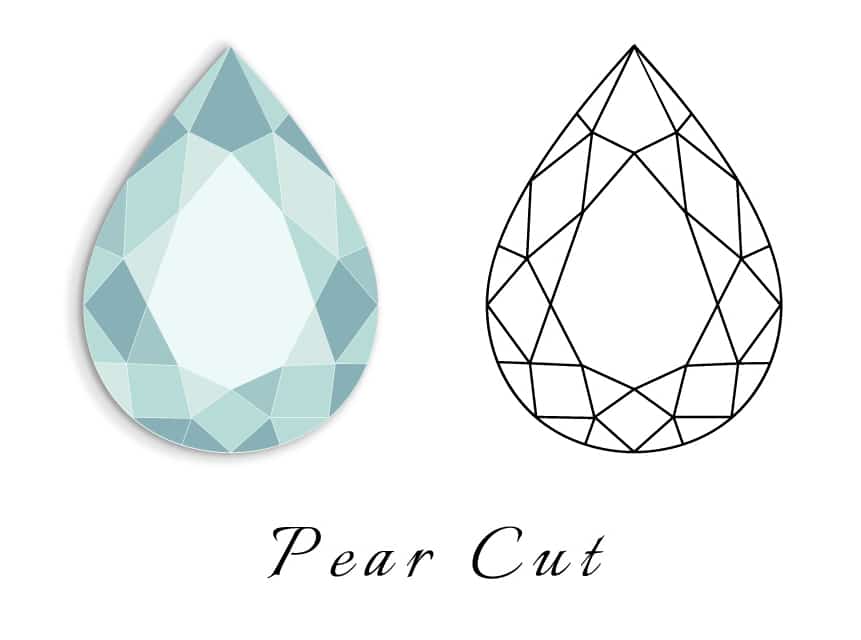
Pear shaped diamonds date back to 1458, when they were introduced by a diamond cutter named Lodewyk Van Berquem. There have been many famous pear shaped diamonds since, including the Millennium Star, Star of the Season, Cullinan and The Star of South Africa.
In a pear brilliant cut, the diamond usually consists of 56 facets and due to its elongated shape, it tends to look larger for its carat weight compared to a round diamond and slenderizes the look of the finger.
Here are tips to help with the proportions of the Pear shape, depending upon whether you prefer a shorter, fatter pear or a longer, slimmer one:
- The edge should be parallel to the top of the rounded end.
- The upper and lower curves on both sides of the diamond should form symmetrical curves.
- The rounded apex should look like a semi-circle.
Pros
- Pear cut diamonds are less expensive when compared to round cut diamonds. Rough diamonds have odd, long shapes, so pear cut diamonds use more of this raw material and there is less wastage.
- Pear diamonds distribute more weight in the bigger end of the diamond making it look larger than other shapes such as princess or cushion though at the same carat weight.
- This shape is versatile in many settings
- Elongates the look of your fingers
- Pear shaped diamonds are not that popular, so are not in high demand
Cons
- The pointed end is subject to breakage, so care is needed for everyday wear.
- Shows inclusions and blemishes, so you will need a high-quality stone.
- This cut requires substantial skill from the cutter to bring out its fire and brilliance.
- May show a bow-tie effect, which is common with poorly cut elongated diamonds shapes
The Look: With its elegant and tapered tear shape, a pear shape diamond is a flattering choice for an engagement ring, combining the attributes of a modern brilliant cut with a marquise cut.
It is a stunning look, slightly different from the typical round solitaire and one that sets you apart from the crowd. Victoria Beckham’s pear-shaped diamond solitaire engagement ring was breath-taking, featuring a center stone of somewhere between 15 and 17 carats
(Tip: Wear the elongated part of the pear shape away from you. This makes your finger look longer.)
8. Radiant Cut Diamonds
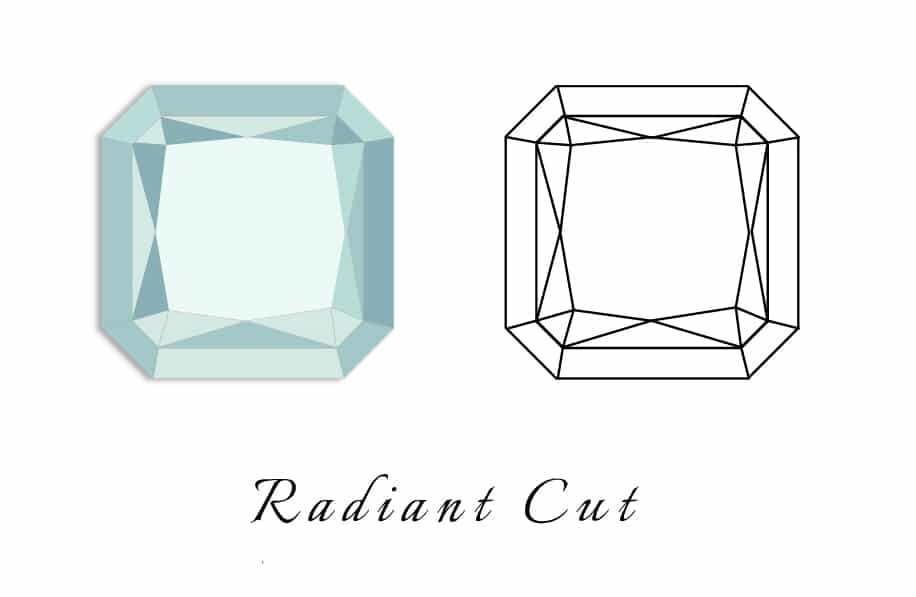
Henry Grossbard designed the Radiant cut in 1977 while aiming to combine the finest elements of the Round brilliant cut and the Emerald cut.
With 70 facets on is pavilion and crown, it has superlative brilliance and fire. The Radiant cut’s brilliance is surpassed only by the Round brilliant cut.
If you are looking for a sparkling, but non-round diamond, the Radiant is a great choice.
Pros
- With 8 carefully beveled corners, Radiants are durable against chipping, snagging and breakage, making it excellent for those with an active lifestyle.
- The Radiant cut is also well known for looking larger than most of the other diamonds of the same carat weight, giving it extra “real estate” on the finger.
- Radiants are highly brilliant cuts, making them stand out more than other cuts.
- The Radiant is a forgiving cut, so you can buy a lesser quality diamond in terms of clarity and coloration.
Cons
- This cut is not as readily available as others as it is not in high demand.
- Because of the characteristic depth of the Radiant cut, it may look smaller than it really is
The Look: Square with beveled corners, the Radiant is elegant, yet updated.
It is seen on the fingers of the crème de la crème celebrities and Hollywood royalties alike. Khloe Kardashian received a 12.5 Radiant from her then-husband Lamar Odom. Jennifer Lopez’s rare pink Radiant given to her by Ben Affleck was supposedly worth $2.5 million.
9. Marquise Cut Diamonds
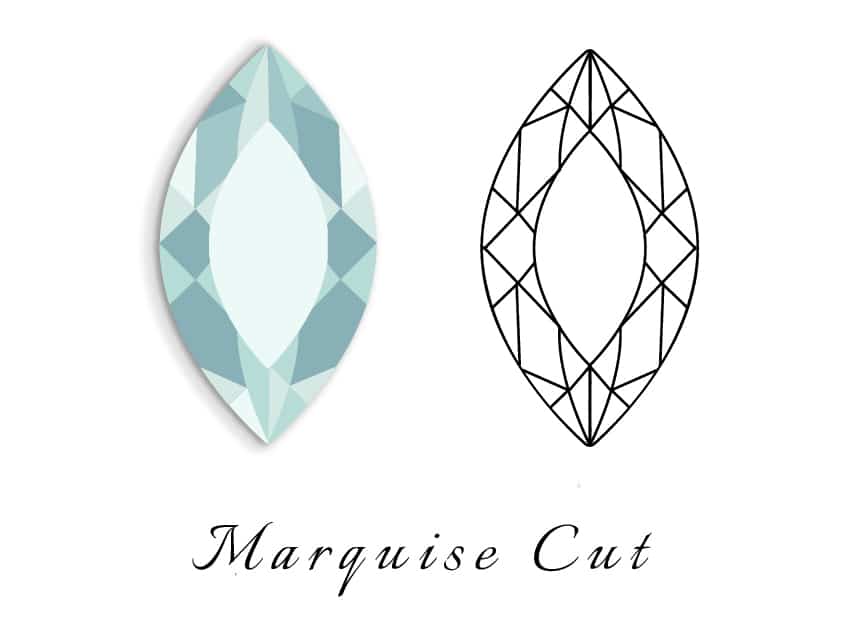
Originally commissioned by King Louis X1V of France for the Marquise de Pompadour, the Marquise is a football shaped, elongated diamond which was allegedly created to echo the shape of her perfect mouth.
It looks like a long oval which has been stretched out to a point at each end. It is usually worn with the oval shape pointing downwards on the finger, but on rare occasions you will see one with the oval worn from side to side. A marquise diamond should have a symmetrical ratio of 2:1 to give it that classic boat shape. They are most often seen as center diamonds for engagement rings and wedding rings, but with side stones to balance the long, narrow shape.
Pros
- The Marquise has the largest crown surface area of any diamond shape, giving the illusion of greater size.
- It is a modified brilliant cut with 58 facets, so has sparkle and scintillation galore.
- Classy, sophisticated looking, romantic links to Louis X1V!
- It is unique looking and relatively unusual so it will make you stand out from the crowd
Cons
- You should think carefully about wearing the Marquise cut if you have an active lifestyle, as its sharp ends can be susceptible to chipping if not protected properly by the jewelry setting. Make sure the corners have protected V-end” or “V-tip” prongs or claws to keep the corners safe.
- With their narrow shape, poorly cut Marquise diamonds can produce an area of reduced color in the center of the gem resembling a bow tie.
The Look: Set with pear or round-shaped side stones to stunning effect, the Marquise is highly romantic choice with a unique, confident shape. Catherine Zeta-Jones was given a 10 carat Marquise diamond engagement ring by Michael Douglas with the pointed ends resting across the band, a more unusual design.
10. Heart Cut Diamonds
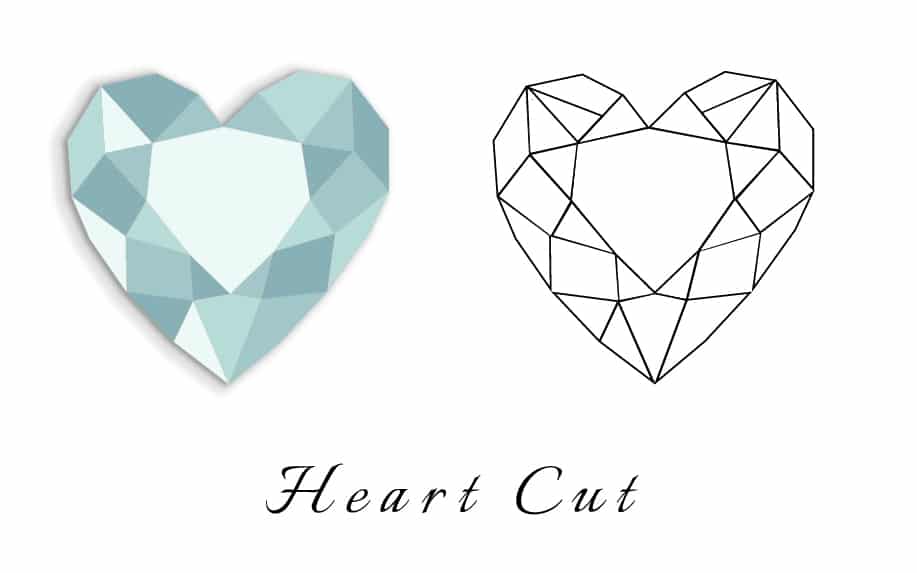
You would expect this shape to be one of the most popular. After all, it is heart-shaped, perfect for an engagement ring!
It is actually one of the most difficult and expensive cuts to produce. Heart shaped diamonds are relatively new on the market because it took several advancements in sophisticated computer technology to be able cut this shape.
To make it, the cutter begins with a wide pear shape, then cuts a cleft in the thicker end to create a heart.
Pros
- The Heart is a relatively new and modern take on the traditional engagement ring diamond
- It is very romantic cut, for obvious reasons!
- It is unique, and you are not likely to see another one like it
- It is eye-catching and can be set alone or with other gemstones for a custom look
- The Heart shape has a meaning, so it is likely to arouse more emotion than other shapes.
Cons
- It can be challenging to create both brilliance and symmetry with this shape, so it is much more expensive to purchase.
- The color and clarity of the diamond you choose must also be almost flawless, because the heart shape shows up all blemishes and if the stone haspoor coloration.
The Look: It is modern, romantic, unique, unconventional and ultra-feminine! The shape has meaning as the ultimate symbol of love, unlike other shapes, so it is likely to be more highly cherished than other shapes. Gwen Stefani was given a heart-shaped engagement ring by her then fiancé Gavin Rossdale.
Conclusion
There you have it – the 10 most commonly found diamond shapes together with the cuts that make each one special.
Whether you take the traditional route and opt for a simple round brilliant or go for something more unconventional that speaks to your uniqueness, one of these shapes is bound to meet your specific requirements and taste.
Again, it is the combination of shape and cut working in unison to create the perfect diamond for you.
If you buy online, be sure to check out your options on James Allen, Blue Nile and Brian Gavin.
They have stunning collections of diamonds in all these shapes and cuts together with professional customer service agents to help you every step of the way.
